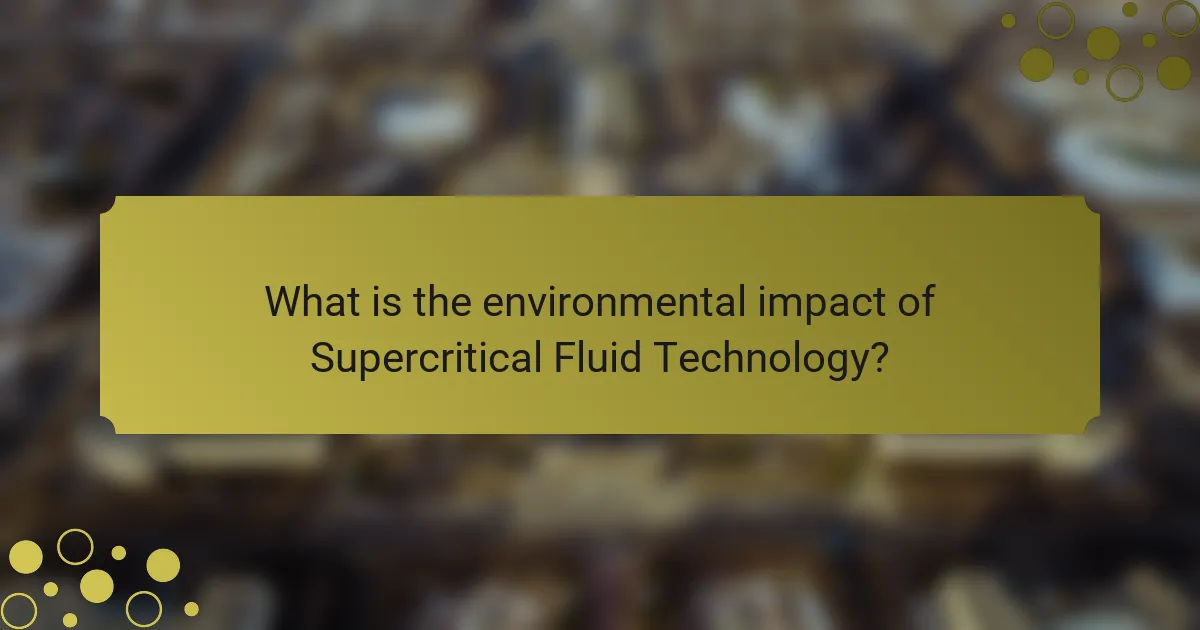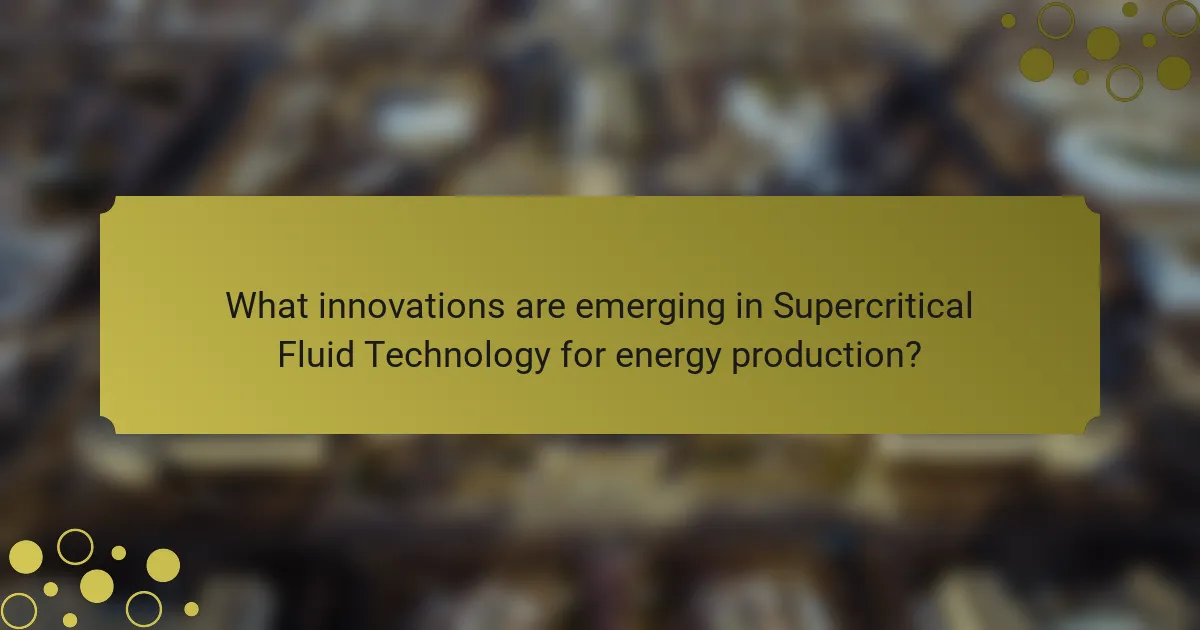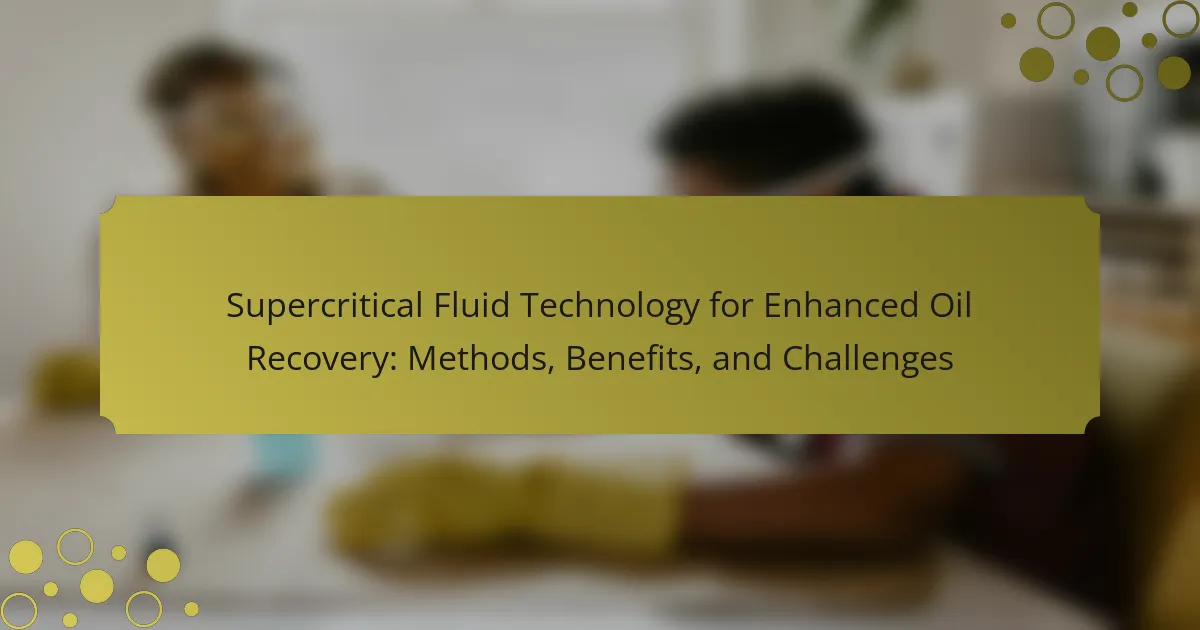Supercritical Fluid Technology is a method that utilizes supercritical fluids—substances at temperatures and pressures above their critical points—to enhance energy extraction and conversion processes. This technology improves efficiency in various applications, including extraction, combustion, and gasification, while also reducing emissions and increasing energy yields. Notably, supercritical water gasification effectively converts organic materials into hydrogen and other fuels. Additionally, innovations such as supercritical carbon dioxide cycles for power generation and advancements in supercritical fluid extraction are driving cleaner and more efficient energy production methods, supporting sustainable practices across industries.

What is Supercritical Fluid Technology in Energy Production?
Supercritical Fluid Technology in energy production utilizes supercritical fluids to enhance energy extraction and conversion processes. Supercritical fluids are substances at a temperature and pressure above their critical point, exhibiting unique properties that facilitate efficient energy production. This technology improves the efficiency of processes such as extraction, combustion, and gasification. For instance, supercritical water gasification converts organic materials into hydrogen and other fuels more effectively than traditional methods. Research indicates that using supercritical fluids can reduce emissions and increase energy yield. Studies show that supercritical CO2 can enhance oil recovery, making it a promising method for sustainable energy production.
How does Supercritical Fluid Technology function in energy production?
Supercritical Fluid Technology functions in energy production by utilizing fluids at high pressure and temperature, where they exhibit unique properties. In this state, the fluid can dissolve materials like a liquid and diffuse like a gas. This dual capability enhances the extraction of energy resources such as biofuels and fossil fuels. The technology improves efficiency in processes like gasification and extraction. For instance, supercritical carbon dioxide is used in enhanced oil recovery, increasing oil yield by up to 20%. Additionally, it reduces harmful emissions compared to traditional methods. This efficiency and lower environmental impact demonstrate the technology’s potential in sustainable energy production.
What are the key characteristics of supercritical fluids?
Supercritical fluids are substances at a temperature and pressure above their critical point. They exhibit unique properties that distinguish them from liquids and gases. Supercritical fluids can diffuse through solids like a gas while dissolving materials like a liquid. This dual behavior makes them effective solvents in various applications. They have low viscosity, which allows for efficient mass transfer. Additionally, supercritical fluids have tunable properties, meaning their solvent power can be adjusted by changing pressure and temperature. These characteristics enable their use in processes like extraction and chemical reactions. For example, supercritical carbon dioxide is commonly used for extracting flavors and fragrances due to its effectiveness and non-toxicity.
How are supercritical fluids generated and maintained?
Supercritical fluids are generated by heating a substance above its critical temperature and applying pressure above its critical pressure. This process transforms the substance into a state where it exhibits properties of both a liquid and a gas. To maintain supercritical conditions, consistent temperature and pressure must be upheld throughout the system. Equipment such as high-pressure pumps and heat exchangers are utilized to achieve and stabilize these conditions. Supercritical fluids are often used in applications like extraction and chemical reactions due to their unique solvent properties. Maintaining the correct parameters is crucial for efficiency and effectiveness in energy production processes.
What are the main applications of Supercritical Fluid Technology in energy production?
Supercritical Fluid Technology is primarily applied in energy production for enhanced oil recovery, biomass processing, and supercritical CO2 power cycles. Enhanced oil recovery utilizes supercritical fluids to increase extraction efficiency from oil reservoirs. Biomass processing benefits from supercritical fluids in converting organic materials into biofuels. Supercritical CO2 power cycles improve thermal efficiency in power generation systems. These applications demonstrate the versatility and efficiency of supercritical fluids in energy production.
Which energy sources utilize Supercritical Fluid Technology?
Supercritical Fluid Technology is utilized in various energy sources. These include biomass conversion, fossil fuel extraction, and enhanced oil recovery. In biomass conversion, supercritical fluids help in extracting biofuels from organic materials. Fossil fuel extraction benefits from supercritical CO2 for improved oil recovery. Enhanced oil recovery techniques use supercritical fluids to reduce viscosity and increase yield. Each application enhances efficiency and reduces environmental impact.
How does this technology enhance energy production efficiency?
Supercritical fluid technology enhances energy production efficiency by increasing the thermodynamic performance of energy systems. It operates at high pressures and temperatures, allowing for better heat transfer and energy conversion. This technology can extract more energy from fuels compared to traditional methods. For instance, supercritical water can dissolve and transport organic materials more effectively. Studies show that systems utilizing supercritical fluids can achieve thermal efficiencies exceeding 45%. This results in reduced fuel consumption and lower emissions. The integration of supercritical fluids in energy production processes leads to significant improvements in overall system efficiency.

What is the environmental impact of Supercritical Fluid Technology?
Supercritical Fluid Technology has a positive environmental impact. It reduces the use of harmful solvents in extraction processes. This technology often utilizes carbon dioxide, which is less toxic and more environmentally friendly. The process minimizes waste generation compared to traditional methods. It also enhances energy efficiency, leading to lower carbon emissions. Studies show that supercritical fluid extraction can achieve higher yields with less energy input. By replacing conventional solvents, it decreases the risk of pollution. Overall, this technology supports sustainable practices in various industries.
How does Supercritical Fluid Technology compare to traditional energy production methods in terms of emissions?
Supercritical Fluid Technology (SFT) produces lower emissions compared to traditional energy production methods. SFT utilizes supercritical fluids, which enhance extraction efficiency and reduce the need for harmful solvents. This technology results in a significant decrease in greenhouse gas emissions. For example, SFT can reduce carbon dioxide emissions by up to 30% compared to conventional methods. Additionally, SFT minimizes particulate matter and other pollutants released into the atmosphere. Studies indicate that energy systems employing SFT are more sustainable and environmentally friendly. Therefore, SFT presents a cleaner alternative for energy production.
What pollutants are reduced through Supercritical Fluid Technology?
Supercritical Fluid Technology reduces pollutants such as volatile organic compounds (VOCs), particulate matter, and heavy metals. This technology utilizes supercritical fluids to extract and dissolve contaminants efficiently. For instance, supercritical carbon dioxide is often employed to remove VOCs from various materials. Studies show that this method can achieve significant reductions in harmful emissions. Additionally, it minimizes the use of hazardous solvents, further decreasing environmental impact. The effectiveness of this technology in pollutant reduction is supported by numerous research findings in environmental science.
How does the energy consumption of this technology affect its overall environmental footprint?
The energy consumption of supercritical fluid technology significantly affects its overall environmental footprint. High energy requirements can lead to increased greenhouse gas emissions if fossil fuels are the energy source. Conversely, when powered by renewable energy, the technology can reduce emissions. For instance, studies show that supercritical fluid extraction can achieve higher efficiency, requiring less energy compared to traditional methods. This efficiency translates to lower operational costs and reduced environmental impact. Additionally, energy-efficient systems can minimize resource depletion and waste generation. Therefore, the source and amount of energy consumed are crucial in determining the environmental footprint of this technology.
What are the potential risks associated with Supercritical Fluid Technology?
Potential risks associated with Supercritical Fluid Technology include high-pressure hazards and chemical toxicity. The technology operates under extreme pressure, which can lead to equipment failure if not properly managed. This can result in leaks or explosions, posing safety risks to operators and surrounding environments. Additionally, the solvents used in supercritical fluid processes may be toxic or harmful. Exposure to these substances can have adverse health effects. Furthermore, the environmental impact of improper disposal of supercritical fluids can lead to contamination of soil and water sources. Therefore, careful monitoring and adherence to safety protocols are essential to mitigate these risks.
What safety measures are in place to mitigate these risks?
Safety measures in supercritical fluid technology include rigorous pressure monitoring and control systems. These systems ensure that pressure levels remain within safe operational limits. Regular maintenance checks are conducted to identify potential leaks or equipment failures. Furthermore, operators are trained in emergency response protocols. Safety valves are installed to release excess pressure automatically. Additionally, containment systems are designed to prevent fluid leaks. These measures help minimize risks associated with high-pressure operations. Adhering to industry standards further enhances safety in supercritical fluid applications.
How do regulatory frameworks address the environmental concerns of this technology?
Regulatory frameworks address the environmental concerns of supercritical fluid technology by setting strict emission standards. These standards limit pollutants released during energy production. Regulations often require environmental impact assessments before project approval. Such assessments evaluate potential ecological effects and mitigation strategies. Compliance with environmental laws is mandatory for operation. Regulatory bodies monitor ongoing operations to ensure adherence to these standards. Penalties for non-compliance can include fines and operational shutdowns. This oversight aims to minimize negative environmental impacts associated with the technology.

What innovations are emerging in Supercritical Fluid Technology for energy production?
Emerging innovations in Supercritical Fluid Technology for energy production include enhanced extraction processes and improved energy conversion methods. Researchers are developing supercritical carbon dioxide (sCO2) cycles for power generation. These cycles offer higher efficiency compared to traditional steam cycles. Additionally, advancements in supercritical fluid extraction (SFE) are enabling cleaner and more efficient extraction of biofuels. The integration of nanomaterials in supercritical fluids is also enhancing reaction rates and product yields. Recent studies indicate that these innovations can significantly reduce greenhouse gas emissions. For example, using sCO2 in concentrated solar power systems can achieve efficiencies exceeding 50%.
How are advancements in materials science impacting Supercritical Fluid Technology?
Advancements in materials science are significantly enhancing Supercritical Fluid Technology (SFT). New materials improve the efficiency and stability of SFT systems. For instance, the development of corrosion-resistant alloys allows for higher pressure and temperature operations. These conditions enhance solubility and extraction capabilities in energy production processes. Research indicates that advanced polymers can reduce energy consumption during supercritical extraction. Moreover, nanostructured materials are being utilized to optimize mass transfer rates in SFT applications. These innovations lead to more sustainable and efficient energy production methods. Overall, materials science advancements are crucial for the evolution of Supercritical Fluid Technology.
What new materials are being developed for better efficiency?
New materials being developed for better efficiency in supercritical fluid technology include advanced polymers and high-temperature alloys. These materials enhance thermal stability and chemical resistance. For instance, polymer composites can withstand extreme conditions while maintaining structural integrity. High-temperature alloys improve performance in supercritical CO2 systems. Research indicates that these materials can increase energy conversion efficiency by up to 10%. Moreover, innovations in nanomaterials are being explored to optimize fluid dynamics. These developments are crucial for improving the overall efficiency of energy production processes.
How do these materials enhance the performance of supercritical systems?
These materials enhance the performance of supercritical systems by improving thermal conductivity and stability. Enhanced thermal conductivity allows for more efficient heat transfer, which is crucial in supercritical fluid applications. Stability of materials ensures that they can withstand high pressures and temperatures without degradation. For instance, advanced alloys are designed to resist corrosion and oxidation, prolonging system lifespan. Research shows that using specific composite materials can increase efficiency by up to 20%. This efficiency gain translates to lower energy consumption and reduced operational costs. Moreover, these materials can help minimize environmental impact by enhancing the overall efficiency of energy production processes.
What role does research and development play in advancing Supercritical Fluid Technology?
Research and development are crucial for advancing Supercritical Fluid Technology (SFT). R&D efforts lead to improved extraction processes and enhanced efficiency. Innovations in R&D help optimize conditions for supercritical fluids, such as pressure and temperature. These advancements increase the yield of desired products while minimizing waste. Research also focuses on developing new applications for SFT in energy production. For instance, studies demonstrate that SFT can improve biofuel extraction processes. Furthermore, ongoing R&D addresses environmental concerns by reducing harmful emissions in energy production. Overall, continuous research and development significantly drive the evolution of Supercritical Fluid Technology.
What are the latest findings in the field of supercritical fluids?
Recent findings in the field of supercritical fluids indicate significant advancements in energy production efficiency. Researchers have developed improved extraction methods using supercritical carbon dioxide for biofuels. These methods enhance yield and reduce energy consumption compared to traditional techniques. Additionally, studies show that supercritical fluids can effectively reduce greenhouse gas emissions during energy production. Innovations in supercritical fluid technology are also being applied to enhance the performance of solar thermal systems. These findings demonstrate the versatility and environmental benefits of supercritical fluids in energy applications.
How can these innovations lead to more sustainable energy practices?
Innovations in supercritical fluid technology can lead to more sustainable energy practices by enhancing energy efficiency. This technology allows for improved extraction processes, reducing waste and energy consumption in energy production. For example, supercritical fluids can extract energy from biomass with higher yields compared to traditional methods. Studies have shown that this can decrease greenhouse gas emissions significantly. Additionally, supercritical fluids can facilitate the use of renewable resources, promoting a circular economy. The integration of these innovations can ultimately lead to a reduction in reliance on fossil fuels, contributing to a more sustainable energy future.
What best practices should be followed when implementing Supercritical Fluid Technology?
Implementing Supercritical Fluid Technology requires adherence to several best practices. First, ensure proper selection of solvents based on their critical properties. This affects the extraction efficiency and product quality. Second, maintain precise control over temperature and pressure during operations. This is crucial for achieving the desired supercritical state. Third, conduct thorough equipment maintenance and regular inspections. This prevents leaks and ensures system integrity. Fourth, optimize the flow rates of the supercritical fluid. This enhances mass transfer and extraction rates. Fifth, implement safety protocols to manage high-pressure systems. This minimizes risks associated with supercritical operations. Lastly, invest in staff training on supercritical fluid processes. Knowledgeable personnel improve operational efficiency and safety. Following these practices leads to improved performance and reliability in supercritical fluid applications.
Supercritical Fluid Technology (SFT) is a method used in energy production that employs supercritical fluids to enhance energy extraction and conversion processes. This article explores the efficiency of SFT, highlighting its applications in enhanced oil recovery, biomass processing, and power generation, while emphasizing its environmental benefits, such as reduced emissions and waste. Key characteristics and generation methods of supercritical fluids are discussed, alongside innovations in materials science and ongoing research that contribute to more sustainable energy practices. The article also addresses safety measures, regulatory frameworks, and best practices for implementing SFT in various energy sectors.



